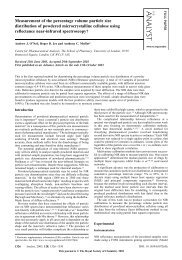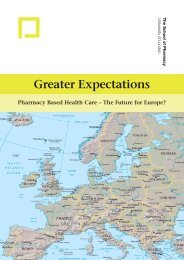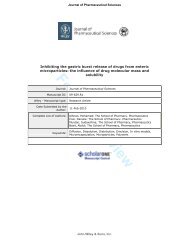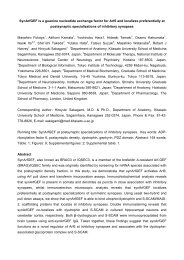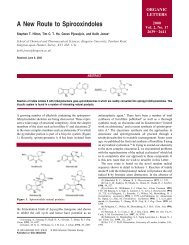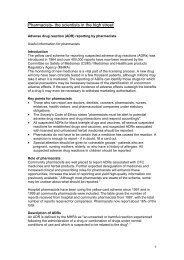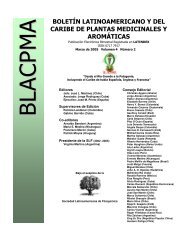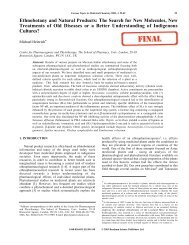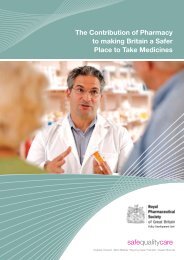Inhaler technique in Turkish people with poor English: a case of ...
Inhaler technique in Turkish people with poor English: a case of ...
Inhaler technique in Turkish people with poor English: a case of ...
Create successful ePaper yourself
Turn your PDF publications into a flip-book with our unique Google optimized e-Paper software.
Pharm World Sci (2006) 28:107–114 111<br />
Approximately, a quarter <strong>of</strong> both language<br />
groups said they had not received <strong>in</strong>itial <strong>in</strong>struction<br />
from a health pr<strong>of</strong>essional on how to use<br />
their <strong>in</strong>halers. There was no difference <strong>in</strong> use <strong>of</strong><br />
spac<strong>in</strong>g devices: approximately a third <strong>of</strong> both<br />
groups used these for at least some <strong>of</strong> their doses.<br />
The EP group were significantly less likely to report<br />
see<strong>in</strong>g the practice nurse about their asthma<br />
than the FE group. Nearly half (45%) the EP<br />
group said they never saw the nurse, compared<br />
<strong>with</strong> 25% <strong>of</strong> the <strong>English</strong>-speak<strong>in</strong>g group. (Chi<br />
square = 6.8, df 1, P < 0.01).<br />
Tables 4 and 5 compare <strong>in</strong>haler <strong>technique</strong>.<br />
<strong>Turkish</strong>-speakers performed better than <strong>English</strong>speakers<br />
<strong>in</strong> terms <strong>of</strong> shak<strong>in</strong>g the <strong>in</strong>haler and were<br />
more likely to check the mouthpiece. However,<br />
there was a marked difference <strong>in</strong> global scores for<br />
<strong>in</strong>haler <strong>technique</strong>, <strong>in</strong> co-ord<strong>in</strong>ation, and <strong>in</strong> breathhold<strong>in</strong>g,<br />
all <strong>of</strong> which were significantly worse <strong>in</strong><br />
the group <strong>with</strong> <strong>poor</strong> <strong>English</strong>.<br />
Impact <strong>of</strong> <strong>in</strong>terventions <strong>in</strong> group <strong>with</strong> <strong>poor</strong><br />
<strong>English</strong><br />
Thirty-four <strong>Turkish</strong> patients <strong>with</strong> EP were<br />
randomised to the MTS group and thirty-five to<br />
the PIL/verbal group. Groups were well matched<br />
for age, gender and basel<strong>in</strong>e (before <strong>in</strong>formation)<br />
<strong>in</strong>haler <strong>technique</strong> rat<strong>in</strong>gs. Only 4 <strong>of</strong> the 35 <strong>people</strong><br />
<strong>in</strong> the MTS group had used a computer. Despite<br />
this, they needed little <strong>in</strong>struction on use <strong>of</strong> the<br />
system.<br />
Changes <strong>in</strong> <strong>in</strong>haler <strong>technique</strong> after <strong>in</strong>formation<br />
are presented <strong>in</strong> Tables 6–8. Half the MTS group<br />
were rated as improved compared to 28% <strong>of</strong><br />
those given a translated leaflet. A further six<br />
<strong>people</strong> (17%) improved after subsequent verbal<br />
advice <strong>in</strong> their own language.<br />
Table 4 Global <strong>technique</strong> assessments <strong>in</strong> fluent <strong>English</strong>speakers<br />
and <strong>Turkish</strong>-speakers <strong>with</strong> <strong>poor</strong> <strong>English</strong><br />
Global <strong>technique</strong> rat<strong>in</strong>g<br />
Poor Adequate Good Total<br />
Fluent <strong>English</strong> 36 48 11 95<br />
(37.9%) (50.5%) (11.6%)<br />
Poor <strong>English</strong> 57 12 0 69<br />
(83%) (17%) –<br />
Chi-square = 30.36 df 2 P < 0.0001<br />
Many subjects had shallow breath<strong>in</strong>g which<br />
made accurate assessment difficult. In some <strong>case</strong>s,<br />
they failed to take any perceptible <strong>in</strong>halation and<br />
five failed to release a dose. Own-language verbal<br />
<strong>in</strong>struction after read<strong>in</strong>g the PIL produced small<br />
but statistically significant improvement <strong>in</strong><br />
breath-hold<strong>in</strong>g.<br />
<strong>Inhaler</strong>-shak<strong>in</strong>g and mouthpiece-check<strong>in</strong>g<br />
improved significantly <strong>in</strong> both groups after <strong>in</strong>formation.<br />
The proportion <strong>of</strong> patients <strong>with</strong> correct<br />
co-ord<strong>in</strong>ation also <strong>in</strong>creased <strong>in</strong> both groups but<br />
numbers were small and changes did not reach<br />
statistical significance.<br />
Multiple quick actuation <strong>of</strong> the <strong>in</strong>haler was<br />
observed <strong>in</strong> 21% MTS and 20% PIL/verbal<br />
before <strong>in</strong>struction. This problem was resolved <strong>in</strong><br />
most subjects by all modes <strong>of</strong> <strong>in</strong>struction.<br />
Discussion<br />
The <strong>in</strong>haler users <strong>with</strong> FE and EP <strong>in</strong> this study<br />
came from three London boroughs <strong>with</strong> diverse<br />
mix <strong>of</strong> ethnic backgrounds and languages.<br />
Approximately, a third <strong>of</strong> the local population <strong>in</strong><br />
each borough had been born outside the UK. All<br />
participants were volunteers who were <strong>in</strong>terested<br />
<strong>in</strong> hav<strong>in</strong>g an ‘‘<strong>in</strong>haler <strong>technique</strong> check’’. The FE<br />
group could all read <strong>English</strong>; most <strong>of</strong> the EP<br />
group could not.<br />
The FE and EP groups were recruited by different<br />
methods, and assessed <strong>in</strong> different sett<strong>in</strong>gs.<br />
We did not take an education history, but the<br />
broad occupational pr<strong>of</strong>ile <strong>of</strong> the two groups was<br />
clearly different, <strong>with</strong> more retired <strong>people</strong> <strong>in</strong> the<br />
<strong>English</strong> group and more women look<strong>in</strong>g after the<br />
home <strong>in</strong> the <strong>Turkish</strong> group.<br />
<strong>Inhaler</strong> <strong>technique</strong> <strong>in</strong> the FE group was <strong>in</strong> l<strong>in</strong>e<br />
<strong>with</strong> previous reports, [5–9] <strong>with</strong> around a third<br />
graded as <strong>poor</strong> and two-thirds hav<strong>in</strong>g some<br />
co-ord<strong>in</strong>ation deficiencies. Global <strong>technique</strong> <strong>in</strong><br />
the EP group was almost universally rated as<br />
<strong>poor</strong>, <strong>with</strong> some extreme co-ord<strong>in</strong>ation problems<br />
observed. It was not possible to compare asthma<br />
severity <strong>in</strong> the two groups, as the researchers only<br />
had access to GP records for patients recruited<br />
through surgeries. However, the reported prescrib<strong>in</strong>g<br />
<strong>of</strong> large volume spacer devices (roughly a<br />
third <strong>of</strong> both groups said they used a spacer)<br />
123



